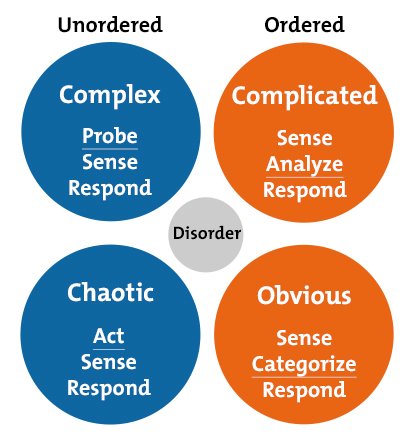
-
Feb8Mon
So what’s the big deal about best practices?
February 8, 2021 Cynefin Framework by Dave Snowden
Cynefin Framework by Dave SnowdenBest practices are ideal for the simple design of a program or an event. We are all aware though that when caring for the vulnerable, a program is seldom simple, rather, as we learn in the Cynefin Framework, we often find ourselves in complicated or complex situations where best practices do not fit the scenario.
I remember a time when a youth pastor called me, frustrated as he was driving to a youth event and there was a lightning storm outside. He saw one of his students walking to the event fighting off the rain and wind and subject to lightning. He was facing a complex situation where he had to either leave the student to nature or break policy and forego the best practice of never driving a student alone in the car. At times like this, we want to buy-in to the myth that Plan to Protect® doesn’t work in complicated and complex situations. However, if you have heard me teach, you know I often speak of good, better, best and bad.
In complicated situations, we are called to sense what is transpiring, analyze the risks and respond with good practices. They may not be the best practices, but we are selecting a good practice that will protect all the stakeholders. In the case of the lightning storm, you would sense the student is in danger, analyze what would be the greater risk (the student’s life in danger) and respond by offering her a ride the rest of the way. A good practice would be to complete an incident report form upon arrival at the church and to notify the student’s parents and your supervisor that you made an exception to the policy and you are being accountable for your actions.
In a complex situation, we are called to probe what is transpiring (to ask questions), to sense how to move forward, and to respond appropriately with the information you have gleaned. An example of a complex situation would be on a short-term global trip when one of the student’s passports is stolen or you are in a car accident in a developing world country. This is complex as you don’t know the way forward. You will need to probe and ask questions of other leaders and partner organizations, and then analyze the risks, and respond with the knowledge you have gained. In situations like this, the Cynefin Framework states that this is an emerging practice. You are writing the practice as you live it out. The more guiding principles you can provide for complex situations the better.
In all cases, you want to avoid the chaotic. Unfortunately, if we don’t invest in the professional development of our leaders and personnel, too often we find ourselves in the chaotic. In the chaotic, what happens is workers will act first, then sense they did something wrong, and then they respond to their actions by either hiding it or dealing with the fallout.
Are you prepared for the complicated and complex situations within your organization? We have all found ourselves in complicated and complex situations with COVID. For some of us, we even discovered that we were in a chaotic place when the media came calling or when the worst happened.
What is your plan to protect?



Comment
On Tuesday, May 4, 2021, Geraldine Rene Chisnell said:
Leave a Comment